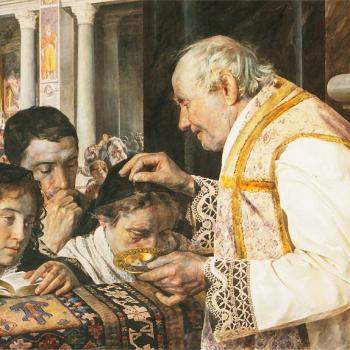Ironically for a trip that was meant to focus on the interaction of various religions with one another, particularly Hinduism and Catholicism, the first place we visited was a small city/state called Auroville and had little to do with religion or Hinduism. Ironically, because Auroville claims to be a spiritual community that lives “beyond” religion. It is the Disney World of “spiritual but not religious.” We were taken around the place by a woman named Lisa, a woman of German descent (with blonde hair in the picture) who had been born in the Auroville community.
 You can read all about Auroville, its founding by Sri Aurobindo and The Mother, its split with the Aurobindo Ashram and the technicalities of its functioning all online. What I would like to reflect on is this claim of being a community beyond religion. In essence what this means for the community of 2000 plus who live in the city – a city that is under construction for 50,000 – is that no religion in particular is taught in any of the classes. Children can opt to go to workshops about religions, but none of them are mandatory. There are no rituals. Everyone experiences the Feminine Spirit in whatever way that they feel free doing.
You can read all about Auroville, its founding by Sri Aurobindo and The Mother, its split with the Aurobindo Ashram and the technicalities of its functioning all online. What I would like to reflect on is this claim of being a community beyond religion. In essence what this means for the community of 2000 plus who live in the city – a city that is under construction for 50,000 – is that no religion in particular is taught in any of the classes. Children can opt to go to workshops about religions, but none of them are mandatory. There are no rituals. Everyone experiences the Feminine Spirit in whatever way that they feel free doing. 
This freedom in regard to experiencing Consciousness of the Mother of all creation is called Yoga. It is an interpretation of Yoga given by Sri Aurobindo, one of the great spiritual leaders of India. He eventually came to the conclusion that no particular practice of yoga, no particular methods of using the Asanas or of any particular guru were any better than an other, but rather than the life of yoga is just a life of perfect integration. Each person must find this integration on their own and by their own methods.
He was also convinced that authentic integral yoga always looks out rather than in. Aurobindo was not interested in forming a community that was intent on naval gazing or was interested only in self-improvement. He wanted a community whose work involved the local community. And so thousands of people in surrounding towns are employed and served by the Auroville people. They go out into the community with programs of education and help people to develop better farming techniques, for example. Women empowerment groups are formed. Re-forestation has been a major part of the work. In other words, rather a rarity for Hindu culture, social justice is a primary concern.
In Hindu culture, because of its emphasis on “ultimate reality” and its relegation of this world to “conventional reality,” much of the work of social justice and charity is left to the side. I will reflect on this more later, but most of the religious hospitals and schools are run by the Christians in India. There are no Hindu hospitals or schools. Such work of charity is considered unnecessary. In many ways, it is a phenomenon that matches in the past many traditional Catholic cultures that were so focused on the other world that little interest was shown in fixing the sinful structures of this one. And so Aurobindo’s emphasis on social justice is an anomalous breath of fresh air.
 One of the most striking features of the Auroville community to any observer is the enormous golden globe or Matrimandir that resides at the geographical center of the city. When Aurobindo died, his spiritual companion, The Mother, took over. She was the major inspiration for the city, and it was under her guidance that the Matrimandir was erected. An enormous globe plated in gold, it is a place for “concentration,” not for meditation, a religious word. For those who want to concentrate, the place is air-conditioned and spacious, with no objects except a clear crystal ball at the center that reflects the sunlight coming in through a hole in the roof. Only those who are serious can enter, and visitors must schedule in advance. We were not able to go in.
One of the most striking features of the Auroville community to any observer is the enormous golden globe or Matrimandir that resides at the geographical center of the city. When Aurobindo died, his spiritual companion, The Mother, took over. She was the major inspiration for the city, and it was under her guidance that the Matrimandir was erected. An enormous globe plated in gold, it is a place for “concentration,” not for meditation, a religious word. For those who want to concentrate, the place is air-conditioned and spacious, with no objects except a clear crystal ball at the center that reflects the sunlight coming in through a hole in the roof. Only those who are serious can enter, and visitors must schedule in advance. We were not able to go in.
 Surrounding the Matrimandir are twelve concentration rooms where people concentrate on different elements of the Mother. No one in the community is required to go to concentrate, but many do.
Surrounding the Matrimandir are twelve concentration rooms where people concentrate on different elements of the Mother. No one in the community is required to go to concentrate, but many do.
Several questions arose from this experience. With absolutely no education in religions of the world, are children really free to choose their own experience of the Absolute Spirit, called by them The Mother? Would not the product that arose from their own personal integrated yoga or journey end up being a shallow experience both of culture and of God? Robbed of all symbols from an early age, can a psyche truly find God? The major religions of the world would speak an emphatic No. The Mother and members of Auroville (but probably not Aurobindo) would say Yes.
It seems no accident that Aurobindo’s companion, The Mother, has the same name as that given to the Absolute Spirit or Consciousness, The Mother. While all religion in name is rejected, The Mother would only appear in public to speak seated on a throne wrapped in robes. She chose the 12 elements of The Mother that should be the objects of contemplation. She designed and oversaw the building of the Matrimandir. In the end, the Ashram that had been connected to Auroville separated from it because they did not like the cult of The Mother that had grown up. They wanted to remain faithful to Aurobindo, and they felt she was not being so. And so the question arises, is the combination of symbol-less symbols and creedless creeds and spiritualities developed by The Mother and revolving around her person not a form of religion? If it looks like a duck and quacks like a duck, isn’t it a duck?
Lisa herself talked about how, after growing up in Auroville, she left for many years to study psychology and world religions before coming back. She disagreed with the idea of not teaching any religions at all to the children. She thought that they should at least be exposed to the major religions of the world. I think she saw that for those who refuse to stand on the shoulders of the giants of the past, only a shallow spectre of spirituality emerges.
In the end, we went to Auroville first because it was only open to visitors one of the days that we were in Chennai. It was an interesting way to being our Theological Immersion, since it opened the question right off the bat of the possibility of religionless spirituality.
















